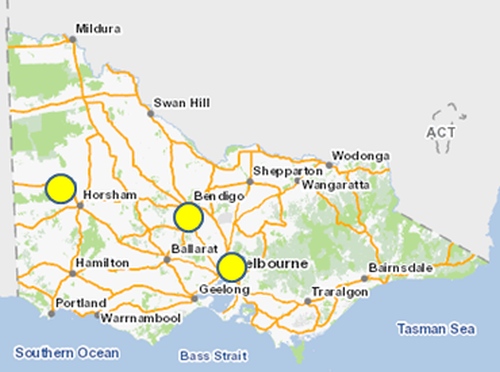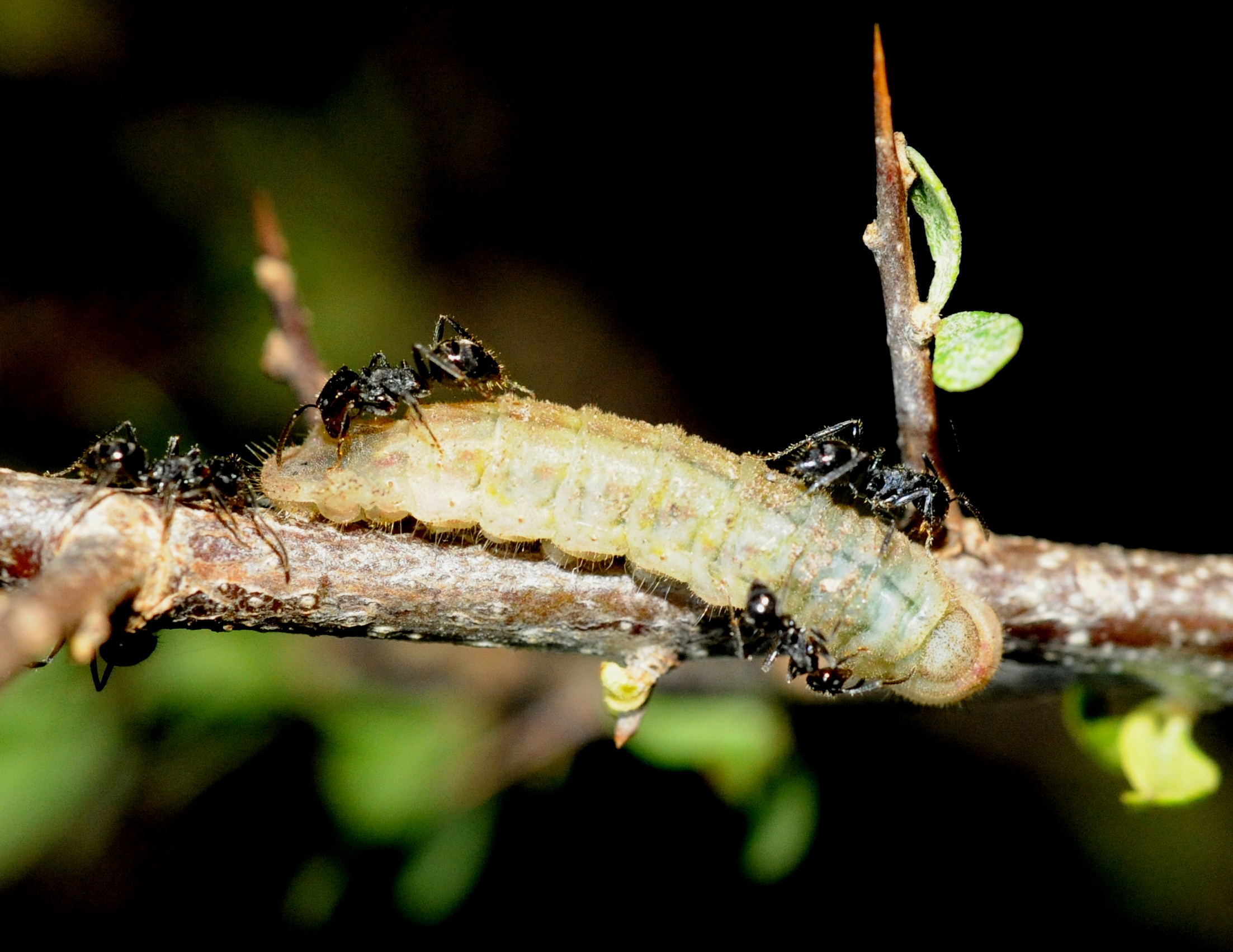Eltham Copper Butterfly in Central Victoria
Who is the Eltham Copper Butterfly?
The Eltham Copper Butterfly (Paralucia pyrodiscus lucida) is only found in Victoria, Australia, and is restricted to a several sites around Castlemaine, Bendigo, Kiata (near Nhill) and Eltham. It is one of the rare good news stories within the extinction crisis in Australia. It was considered extinct in the 1950s until rediscovered at Eltham in 1986.
Although new populations have been discovered around the state since the Eltham discovery in 1986, the future of this special butterfly remains uncertain. It is listed as threatened under the Victorian Flora and Fauna Guarantee Act 1988 and listed as endangered under the Commonwealth Environmental Conservation and Biodiversity Act 1999. This places considerable importance on the seven sites around the Castlemaine region in central Victoria, where the butterfly exists and has bred successfully.
Connecting Country has developed an excellent brochure for the Eltham Copper Butterfly. To download a copy – click here

The Eltham Copper Butterfly is only known from three general locations in Victoria (image by SWIFFT)
Not only is this beautiful species threatened, it also has fascinating and highly specialised ecological requirements. It cannot survive without the presence of Sweet Bursaria (Bursaria spinosa) plants and colonies of a particular species of Notoncus ants.
Scroll through to enjoy this gallery of Eltham Copper Butterfly photos by local ecologist, Elaine Bayes, and Damien Cook.
Ecology and habitat
The Eltham Copper Butterfly is a small attractive butterfly with bright copper colouring on the tops of its wings. It is endemic to Victoria, where it mostly lives in dry open woodlands. The Castlemaine-Bendigo population covers the largest area (>100 ha but full extent unconfirmed), followed by Kiata (90 ha) and Eltham-Greensborough (8 ha). The Eltham Copper Butterfly is only ever found in areas where Notoncus ant colonies are present, confirming they have a truly symbiotic relationship.
Adult Eltham Copper Butterflies lay their eggs at the base of Sweet Bursaria plants. The larvae hatch and make their way to the ant nest, where the caterpillars are guarded by the ants, which lead them to and from the ant colony to browse on the Sweet Bursaria leaves. In return, the ants feed on sugar secretions which are exuded from the caterpillars’ bodies.
Larvae pupate in or near the ant nest, with adults emerging from October to March each year, peaking from November to January. The adults feed on nectar of Sweet Bursaria flowers, and flowers of other plants such as Hakea species.
The following video was produced by Friends of the Eltham Copper Butterfly group, filmed near Eltham, Victoria. It shows the unusual relationship with a particular species of Notoncus ant and a specific plant species, Bursaria spinosa. Amazingly, the butterflies won’t be found if either this plant or ant are absent. The video provides excellent footage of the butterfly, the Notoncus ant and the special relationship they share.
How to identify an Eltham Copper Butterfly
The Eltham copper butterfly is small with bright copper colouring on the tops of its wings, which is visible during the summer flight season. It has a wingspan of 25 to 27 mm. The underside of both wings is brown of various shades, with a series of darker brown, irregular, ‘zig zag’ lines.
It is somewhat similar in colouring to the Common Ground Butterfly, which is common in central Victoria. However, it is much smaller and has different markings on the wings, as visible in the following photos.

The Eltham Copper Butterfly has splendid copper colours and a wingspan of 2-3 cm (photo by Elaine Bayes)

Not an Eltham Copper Butterfly! – The Common Brown Butterfly is orange and brown and has a wingspan of 6-7 cm (photo by Elaine Bayes)
Conservation status
In 1991 Eltham Copper Butterfly was listed as threatened under the Victorian Flora and Fauna Guarantee Act 1988. In 2016 it was listed as endangered under the Commonwealth Environmental Conservation and Biodiversity Act 1999.
The central Victorian population around Castlemaine and Bendigo was only discovered in 2007. As the largest known area of habitat, it is likely to be the key population for survival of this species.
Mapping in the Castlemaine-Bendigo area has revealed sites located from 1.2 km to 7.0 km apart, sometimes disconnected by roads and areas of cleared land. However, lack of resources has limited the extent of butterfly surveys. Many areas between known populations have never been surveyed. Finding further populations of the butterfly and its preferred habitat is a priority, on both public and private land.
It is still likely that undiscovered populations of the Eltham Copper Butterfly exist around Castlemaine, an exciting and challenging prospect. Further funding and research is essential to ensure butterfly populations and habitat can be identified, appropriately managed and protected. Without this information, Eltham Copper Butterfly are at risk from fuel reduction burning and other threats.
Some of the locations where Eltham Copper Butterfly has been found in the Castlemaine region are shown on the following map.
Threats and conservation
Major threats to Eltham Copper Butterfly are:
- Inappropriate planned burning.
- Wildfire.
- Habitat loss, particularly loss of Sweet Bursaria plants and habitat supporting Notoncus ants.
- Invasion by environmental weeds, leading to degraded habitat.
- Competition for food and nectar.
Fire is the number one threat to this species. It is critical that we search for unrecorded populations so they can be protected, particularly from planned burns. Sweet Bursaria provides vital habitat and must be protected from over burning for the butterfly to survive.
In the past, areas of planned fuel reduction burning have included sites where Eltham Copper Butterflies live. Thanks to community input, these areas were subsequently excluded from burning or burning times altered. Although fire safety is important, there are alternative methods of fuel reduction and fire risk management.
Castlemaine Field Naturalists Club, Mount Alexander Shire Council, public land managers, Friends of Kalimna Park, local ecologists and volunteers have been supporting local butterfly populations by weed management, education and revegetation.
With good management of Eltham Copper Butterfly habitat and increased community awareness, we can protect this special species into the future.
How can you help?
You can take action to help the Eltham Copper Butterfly:
- Retain and restore native understorey plants on your property, especially if it contains Sweet Bursaria.
- Remain on pathways during walks through public land and keep all pets on a lead.
- If you have seen the species, take a photo and send to info@connectingcountry.org.au and once confirmed add to the Atlas of Living Australia (see below).
- Join the Eltham Copper Butterfly monitoring program and help us monitor and discover populations of this unique and amazing species.
- Volunteer at local events that support habitat restoration and weed removal.
How to record an Eltham Copper Butterfly sighting
There are several ways to report sightings of this threatened species.
You can email a photograph to Connecting Country (info@connectingcountry.org.au), for confirmation of identification, and we can upload the record to relevant online databases.
However, the easiest way to submit your sighting is through the Atlas of Living Australia (ALA), which is a large nationwide database containing information about Australian plants and animals. Once you are registered with the ALA, you can submit records and images to contribute to the data for this species.
To record an Eltham Copper Butterfly sighting on the ALA – click here.















